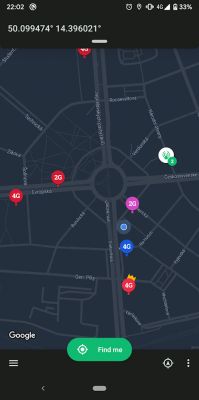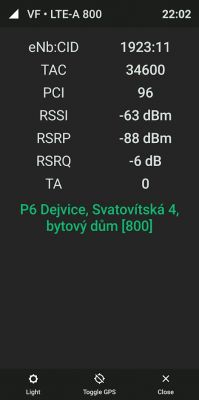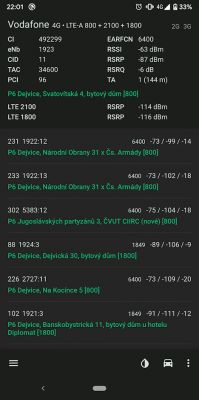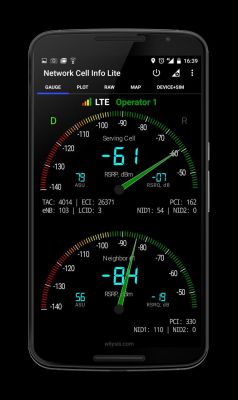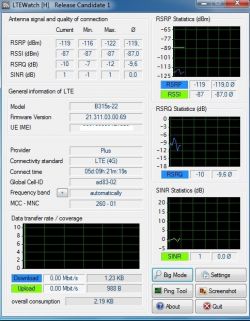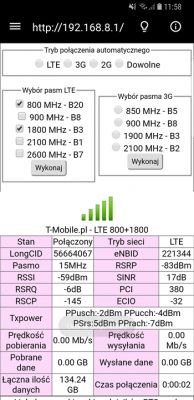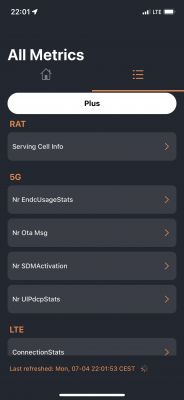Together, we create a new guide - I am asking for comments - suggestions for PW
How to perform LTE signal measurement on your own device
- NetMonster - universal android application that allows you to read the signal level and other data sent by BTS in communication with our phone for mobile networks - Link - Google Play
- Network Cell Info - is an application for carrying out more advanced measurements. Its indicators inform not only about the signal quality, but also about detailed parameters and changes over time. Information is refreshed every second and can also be viewed on charts. The map will show the approximate location of the transmitter to which the smartphone is currently connected - Link
- LTE Watch - a PC application that allows you to read signal data from Huaweii's routers - Link
- HManager - an android application that allows you to read the signal parameters from the Huaweii router on the phone - attachment
GSM signal parameters and their translation into device operation:
RSRP (dBm) - (Reference Signal Receive Power {Received Power of the Reference Signal}) - signal strength measure
Device indications -> from -140 to -44 dBm
more than -79dBm [more than RSRP62] - very good close to the BTS
from -80dBm to -90dBm [RSRP61 - RSRP51] - good
from -91 to -100 [RSRP50 - RSRP41] - you have to think about changing the position of the modem / router or buying an antenna
less than -100 [less than RSRP40] - very bad, practically impossible to work.
RSRQ (dB) - (Reference Signal Received Quality) - measure of signal quality
Display range - from -19.5dB to -3 dB
more than -9dB - very good, close to the BTS
from -10dB to -15dB - good
from -16dB to -20dB - you have to think about changing the position of the modem / router or buying an antenna
below -20dB - it is impossible to work very badly.
SINR (dB) - (signal-to-interference-plus-noise ratio) - a measure of the quality of the useful signal in relation to noise disturbance
more than 21dB - very close to the BTS
from 13dB to 20dB - good
from 0dB to 12dB - you have to think about changing the position of the modem / router or buying an external antenna
less than 0dB - it is impossible to work very badly.
RSSI (dBm) - (Received Signal Strength Indicator) - auxiliary measure; received signal strength indicator, including interferences, which translates poorly into the strength of the useful signal delivered to the user; the greater the data transfer activity, the greater the RSSI
more than -57dBm
-58dBm to -79dBm
-80dBm to -96dBm
less than -96dBm
How to perform LTE signal measurement on your own device
- NetMonster - universal android application that allows you to read the signal level and other data sent by BTS in communication with our phone for mobile networks - Link - Google Play
-------------------------------------------------- -------------------------------------------------- ----------------------------------------------
- Network Cell Info - is an application for carrying out more advanced measurements. Its indicators inform not only about the signal quality, but also about detailed parameters and changes over time. Information is refreshed every second and can also be viewed on charts. The map will show the approximate location of the transmitter to which the smartphone is currently connected - Link
-------------------------------------------------- -------------------------------------------------- ---------------------------------------------
- LTE Watch - a PC application that allows you to read signal data from Huaweii's routers - Link
-------------------------------------------------- -------------------------------------------------- ----------------------------------------------
- HManager - an android application that allows you to read the signal parameters from the Huaweii router on the phone - attachment
-------------------------------------------------- -------------------------------------------------- ----------------------------------------------
GSM signal parameters and their translation into device operation:
RSRP (dBm) - (Reference Signal Receive Power {Received Power of the Reference Signal}) - signal strength measure
Device indications -> from -140 to -44 dBm
more than -79dBm [more than RSRP62] - very good close to the BTS
from -80dBm to -90dBm [RSRP61 - RSRP51] - good
from -91 to -100 [RSRP50 - RSRP41] - you have to think about changing the position of the modem / router or buying an antenna
less than -100 [less than RSRP40] - very bad, practically impossible to work.
RSRQ (dB) - (Reference Signal Received Quality) - measure of signal quality
Display range - from -19.5dB to -3 dB
more than -9dB - very good, close to the BTS
from -10dB to -15dB - good
from -16dB to -20dB - you have to think about changing the position of the modem / router or buying an antenna
below -20dB - it is impossible to work very badly.
SINR (dB) - (signal-to-interference-plus-noise ratio) - a measure of the quality of the useful signal in relation to noise disturbance
more than 21dB - very close to the BTS
from 13dB to 20dB - good
from 0dB to 12dB - you have to think about changing the position of the modem / router or buying an external antenna
less than 0dB - it is impossible to work very badly.
RSSI (dBm) - (Received Signal Strength Indicator) - auxiliary measure; received signal strength indicator, including interferences, which translates poorly into the strength of the useful signal delivered to the user; the greater the data transfer activity, the greater the RSSI
more than -57dBm
-58dBm to -79dBm
-80dBm to -96dBm
less than -96dBm



